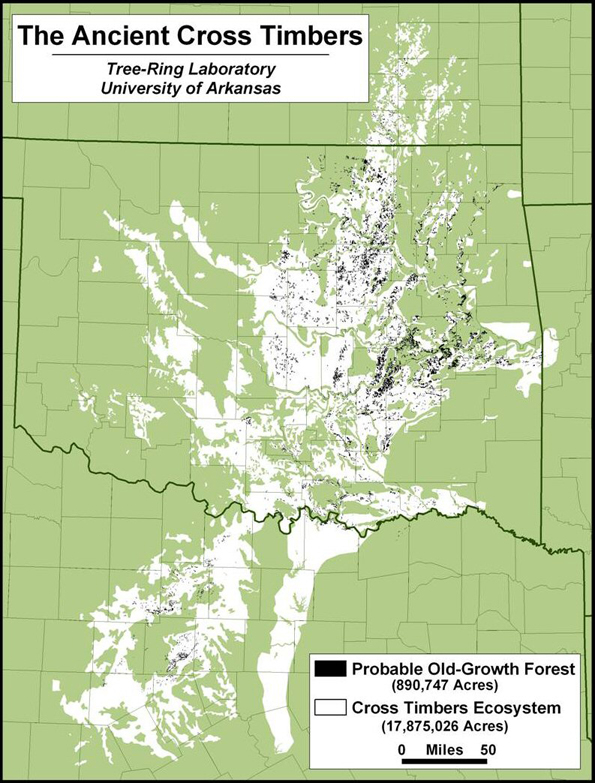
Large tracts of ancient deciduous forest still grace the ridges and rugged escarpments of southeast Kansas, Oklahoma, western Arkansas, and central Texas. These interesting woodlands are dominated by centuries-old post oak (Quercus stellata) and are part of the Cross Timbers ecosystem. The Cross Timbers are a complex mosaic of upland forest, savanna, and glade that form the broad ecotone between the eastern deciduous forests and the grasslands of the southern Great Plains. The presettlement Cross Timbers are believed to have covered approximately 28,000 square miles (7,250,000 hectares), extending from central Texas across Oklahoma into southeastern Kansas. The short, stout oaks of the Cross Timbers were not ideal for lumber production, so the original Cross Timbers have often survived on steep terrain that was unsuitable for farming. Literally thousands of ancient post oak can still be found in this region, and the Cross Timbers is one of the least disturbed forest types left in the eastern United States.
Many public and private land managers do not realize that ancient forests survive extensively across the rugged terrain of the Southern Plains, but the Cross Timbers do not satisfy the stereotype for ancient forests, which remains fixated on giant redwoods or massive hardwoods. The Cross Timbers are drought-stressed woodlands, populated by low-stature, slow-growing trees, many of which predate not only statehood, but also the birth of the United States. Millions of 200- to 400-year old post oak survive in the Cross Timbers, and red cedar (Juniperus virginiana) trees over 500-years old have also been found on fire-protected blufflines. Our failure to understand the ancient Cross Timbers is contributing to the ongoing destruction and fragmentation of this ecosystem, which is a major threat to regional biodiversity, water quality, and recreational values. The Ancient Cross Timbers Consortium has been established to promote research, education, and conservation in these interesting and authentic American woodlands.
This map illustrates the potential natural distribution of the Cross Timbers ecosystem (dark green polygons), according to Kuchler (1964, “Potential Natural Vegetation of the Coterminous United States” American Geographical Society, Special Publication 36, type 75). The original Cross Timbers on level soils have been largely cleared for cultivation and grazing. However, extensive surveys associated with the research of Matt Therrell, Sophonia Roe, Alynne Bayard, Krista Peppers, Stacy Clark, Dan Griffin, Jesse Edmondson, Dorian Burnette, and Dave Stahle indicates that hundreds of square miles of ancient Cross Timbers survive in a fragmentary pattern on steep terrain from Kansas, across Oklahoma, extreme western Arkansas, and into central Texas (as estimated by the black polygons). Old growth woodlands also survive locally in the “Post Oak Savanna” of southern Texas (Kuchler’s type 91, not shown).